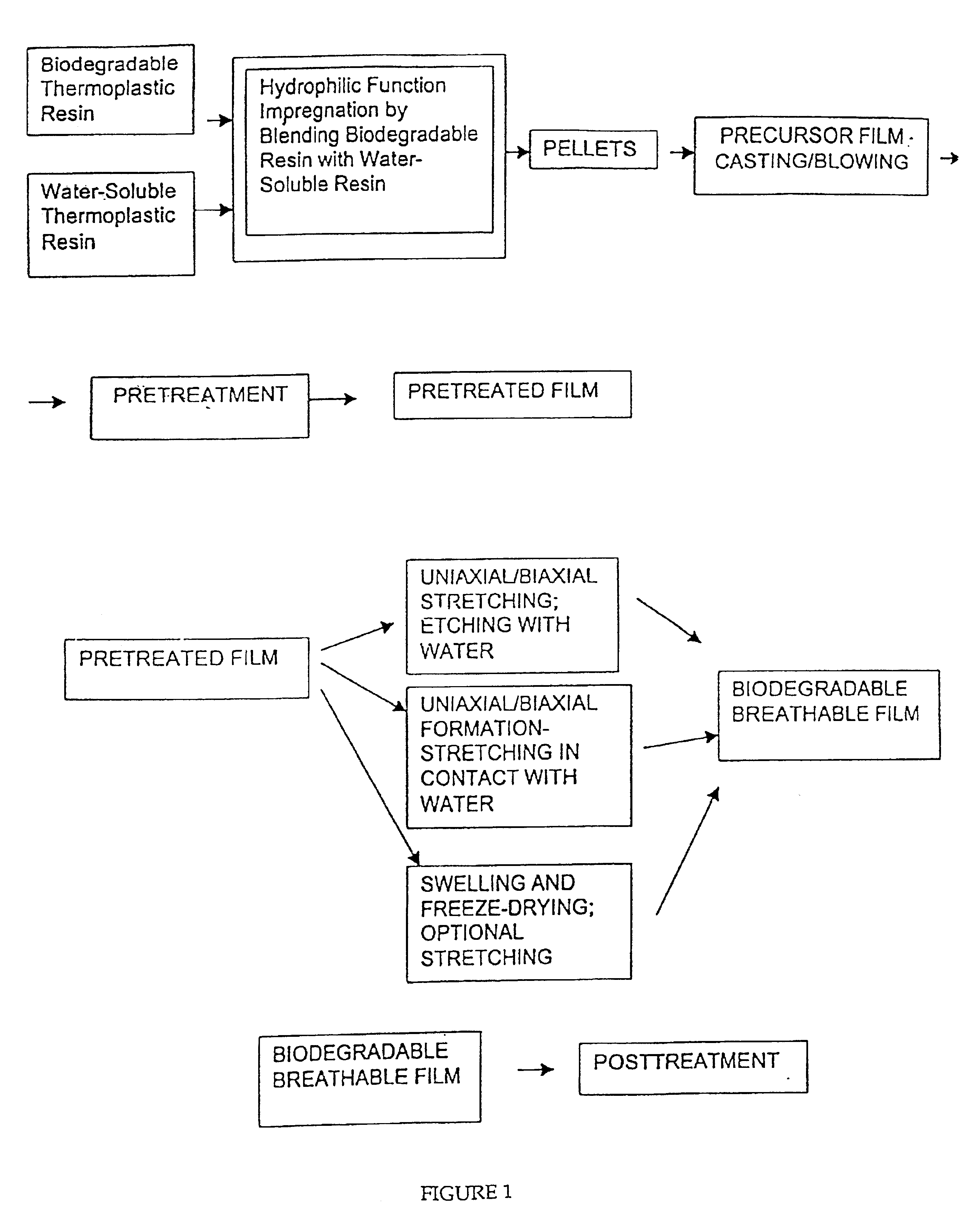Biodegradable films having enhanced ductility and breathability
a biodegradable film, ductility technology, applied in the direction of synthetic resin layered products, bandages, transportation and packaging, etc., can solve the problems of affecting the ductility of the toilet or the pipe connecting the toilet to the sewage system, the inability to dispose of disposable absorbent products, and the difficulty of achieving the disassembly of many disposable absorbent products, etc., to achieve enhanced ductility and softness, enhanced breathability and softness, and ductility and soft
- Summary
- Abstract
- Description
- Claims
- Application Information
AI Technical Summary
Benefits of technology
Problems solved by technology
Method used
Image
Examples
example 1
Preparation of Polyethylene Oxide Resins
[0063]In this example, the following unmodified and modified polyethylene oxide (PEO) resins were used: 1) A grafted PEO 205 resin was produced using batches containing 98.7% by weight WSR-205 Polyox® powder resin supplied by Union Carbide Corporation (molecular weight of 600,000 g / mol), 1.3% by weight TiO2 pigment, a stabilizer package including 1000 ppm Irganox® 1010, 1000 ppm Irganox® 1076, and 2000 ppm Irgafos® 168. The dry blended powder batches were then reactively extruded with 1.5% by weight of 2-hydroxethyl methacrylate (HEMA) and 0.15% by weight peroxide, Lupersol 101, using a ZSK-30 twin screw extruder (manufactured by Werner & Pfleiderer) at a rate of 20 lbs / hr. The resulting extrudant was then pelletized. 2) A grafted PEO N80 resin was produced using Polyox® WSR-N80 powder resin from Union Carbide Corporation. The resin was extruded using the ZSK-30 twin screw extruder operated at a rate of 20 lbs / hr. Polyethylene glycol methacryl...
example 2
Polyethylene Oxide / Bionolle 3001 Polymer Blend Preparation
[0064]The water soluble resin of Example 1 and a Bionolle® 3001 biodegradable aliphatic polyester resin were fed into a ZSK-30 twin screw extruder at a rate of 20 lb / hr. The extruder temperatures were set at 170, 180, 180, 180, 180, 180, and 170° C. for zones 1 through 7 on the extruder. Blends comprising the following weight percent ratios based on total weight of the blend were produced: 15 / 85 grafted PEO N80 / Bionolle® 3001, 25 / 75 grafted PEO N80 / Bionolle® 3001, 50 / 50 grafted PEO N80 / Bionolle® 3001, 15 / 85 grafted PEO 205 / Bionolle® 3001, 25 / 75 grafted PEO 205 / Bionolle® 3001, 50 / 50 grafted PEO 205 / Bionolle® 3001.
example 3
Polyethylene Oxide / Bionolle 3001 Precursor Film Preparation
[0065]Precursor films were produced from the blended resins of Example 2 using a Haake twin screw extruder assembled with a melt pump and 4″ film die. Enhanced wettability was imparted into the precursor films by blending with the water-soluble resin (see FIG. 1). During film processing, the screw speed was held constant at 21 rpm. The melt pump speed was adjusted to accommodate the different flow properties of the resins. A chilled wind-up roll that was maintained at 15 to 20° C. was used to collect the film. Films with a targeted thickness of about 1 mil to about 2 mil were collected from each resin. The film tensile properties and water vapor transport rate were analyzed.
Tensile Properties and Breathability of the Polyethylene Oxide / Bionolle 3001 Precursor Films
[0066]Tensile properties of the precursor films made from blends of Bionolle 3001 resin and grafted PEO are illustrated in Tables 1 and 2. The tensile properties w...
PUM
 Login to View More
Login to View More Abstract
Description
Claims
Application Information
 Login to View More
Login to View More - R&D
- Intellectual Property
- Life Sciences
- Materials
- Tech Scout
- Unparalleled Data Quality
- Higher Quality Content
- 60% Fewer Hallucinations
Browse by: Latest US Patents, China's latest patents, Technical Efficacy Thesaurus, Application Domain, Technology Topic, Popular Technical Reports.
© 2025 PatSnap. All rights reserved.Legal|Privacy policy|Modern Slavery Act Transparency Statement|Sitemap|About US| Contact US: help@patsnap.com

